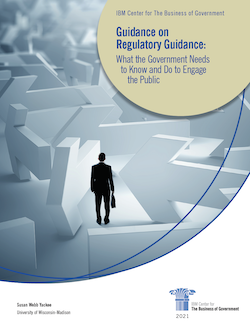
Guidance on Regulatory Guidance: What the Government Needs to Know and Do to Engage the Public

Federal agencies routinely issue guidance documents to clarify the meaning of existing statutes and regulations. Over time, guidance has become a principal tool to help implement regulations. However, agencies have no uniform process for issuing guidance, no common way to engage the public, and no archival record of past policies. As Professor Yackee argues, this creates a mismatch between: (1) the importance of this policy tool, and (2) the ability of the public to influence the policies that govern them.
In this new report, Professor Yackee produces useful insights into current government practices for issuing guidance, how best to bring the public into the development and issuance of guidance through new innovation and process reforms, and timely recommendations for the new Biden administration to foster public engagement. The report presents a roadmap that can help enable agencies to issue guidance in a practical manner that addresses public input. Professor Yackee concludes with several recommendations for improving the guidance process, including standardized definitions that all agencies could adopt, development of a central online repository for guidance, and leveraging technology to enhance public knowledge of and participation in guidance development.
The report builds on the Center’s longstanding research on ways to improve public engagement with government across key program, process, and management domains—including the recent essay on “Community-Driven Government— Reimagining Systems in a Pandemic” contained within our report, COVID-19 and its Impact; The Road to Agile Government: Driving Change to Achieve Success; Transforming How Government Operates: Four Methods of Change; and Applying Design Thinking to Public Service Delivery.



